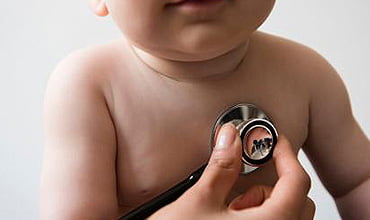





PEDIATRIC TREATMEN AND SURGERIES

PEDIATRIC TREATMENT AND SURGERIES
The Pediatric surgery discipline deals with the diagnosis pre-operative, operative and post-operative periods of diseases that require surgical intervention in children. Surgical interventions for pediatric patients starting from birth until they reach the age of 18 is not only focused on curing the disease, but also aims to protect the psychological development of children. The difference between pediatric surgery and adult surgery is based on physiological and psychological differences. Since hormonal regulation has just begun in newborns, their metabolism is different. Their immune system is not strong enough yet, so their resistance to infections is low. Since the cell renewal rate of children is higher than in adults, recovery times after surgeries and traumas are shorter. Applications of pediatric surgery requires multidisciplinary work in coordination with many different departments such as neonatal units, intensive care, imaging, trauma, pediatric urology and oncology.
Is the Timing of the Operations in the Field of Pediatric Surgery Important?
The timing of surgical interventions in children with more sensitive psychology and physiology than adults is important for the smooth continuity of the treatment process and the child’s up coming life. If there is no emergency, surgical intervention is performed when the child is both psychologically and physiologically ready. If the child has upper respiratory tract or urinary tract infection or hemoglobin level is not 9-10, surgical intervention is not performed until these problems are resolved. On the other hand, speaking in a language that the child to be operated on can understand is important, it is also better for the child to tell the situation without frightening or deceiving the child and not lie to the child.
Children with the age range of 1.5-6 are given medication about half an hour before the surgery. We aim to solve possible psychological problems in advance by preparing the children for the surgery with an appropriate language.
What are the Diseases Treated by Pediatric Surgery?
– Congenital anomalies,
– Hernia in the groin, abdomen and belly, hydrocele, Two or one of the testicles does not descend into the scrotum,
– The urinary hole is not in place,
– Adherence of the foreskin,
– Deformities in the back or rib cage,
Benign tumors called red hemangioma and lymphangioma that can be seen in many parts of the body,
– Benign and malignant tumors that occur with a mass that can be seen in the internal organs and are specific to childhood,
– Various intraabdominal inflammatory diseases that may occur before or after birth, – All congenital or subsequent abdominal pain, especially appendicitis,
– Emergency and post
– Interventions due to accidents such as falling, hitting, burns, injury, foreign body ingestion, Goiter surgery,
– Hemorrhoids,
– anal fissure,
– anal abscess,
– Constipation,
– Megacolon (excessive enlargement of the large intestine),
– Intestinal knotting,
– Intestinal obstruction,
– Intestinalatresia (small intestine atresia),
– Mesenteric cyst,
– Bile atresia (biliary atresia) in newborns,
– Short bowel syndrome,
– Necrotizing enterocolitis,
– Hirschsprung disease,
– Kidney cysts, abscesses and tumors,
– Liver and biliary tract cysts, abscesses and tumors,
– Pancreatic cysts, abscesses and tumors,
– lung cysts, abscesses and tumors,
– Ovarian cysts, abscesses and tumors, Tumors seen in the adrenal gland,
– Stenosis of the anus,
– Anus being in front,
– Urinary system disorders, urinary reflux, hypospadias, epispadias,
– Sex development defects,
– The bladder is outside,
– Abdominal organs such as gastroschisis and omphalocele are outside, Congenital diaphragmatic hernia, Curvature and masses in the neck area,
– Urinary tract and kidney diseases that constantly cause urinary tract infections,
– Shortness of breath, inability to poo, bloody poo, incontinence, urinary incontinence, inability to urinate, which occurs from birth,
– Obstruction of the small intestine,
– Large intestine or esophagus,
– Some or all of the heart or intestines are outside,
– Congenital anomalies such as adhesions in arms,
legs or fingers,
– Blockages in the stomach tube or intestines,
– Vomiting due to gastroesophageal reflux,
– Umbilical granuloma,
– Removal and treatment of foreign bodies and chemicals entering the respiratory and digestive tracts, Biopsy,
– Endoscopic imaging of internal organs.

